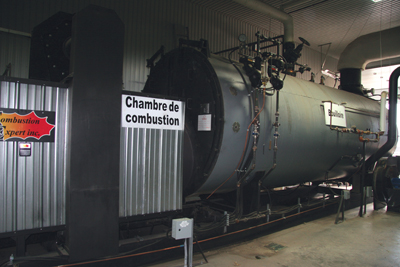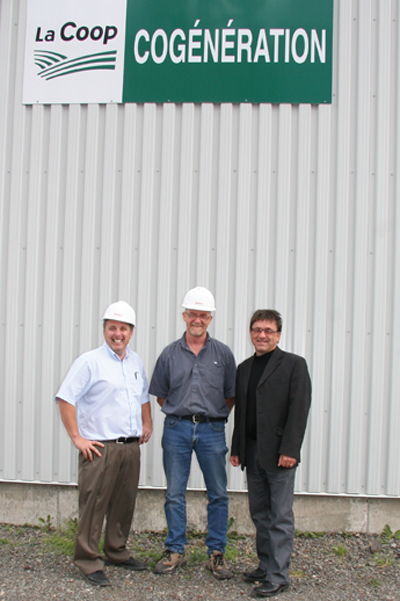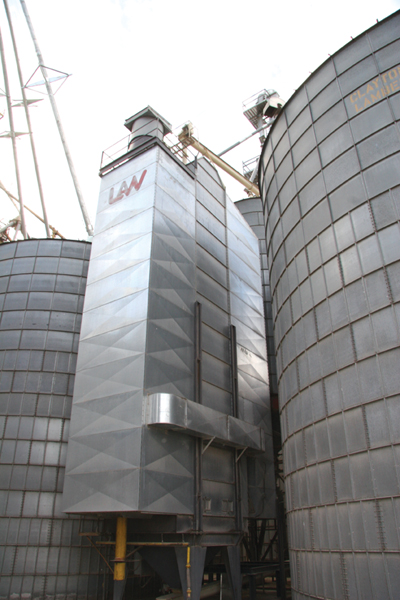
Fuel for Feed
October 20, 2009
By Martine Frigon
The Groupe Dynaco Agri-Food Cooperative has been reaping the benefits of biomass power for almost a year now. The co-op’s feed mill, located in Saint-Philippe-de-Néri in eastern Quebec, is the first in the province, and possibly all of Canada, to use biomass as energy for livestock feed processing.
The Groupe Dynaco Agri-Food Cooperative has been reaping the benefits of biomass power for almost a year now. The co-op’s feed mill, located in Saint-Philippe-de-Néri in eastern Quebec, is the first in the province, and possibly all of Canada, to use biomass as energy for livestock feed processing. According to the mill’s managers, the new biomass energy system has resulted in savings of at least 80% of the energy costs in propane, and totally eliminates the use of fuel oil.
 |
|
| The biomass system was manufactured by Combustion Expert and fitted with a 300-hp (3-MW) boiler designed by Groupe Simoneau.
|
Groupe Dynaco Co-op is involved with various agricultural sectors, including poultry producers, hog producers, vegetable producers, and milk transport and quality, as well as the feed mill. About 650 of the co-op’s 1,500 members are crop and livestock producers. The co-op also has a hardware chain and businesses specializing in sales of fuel and farm machinery. It is ranked the 10th most important employer in Quebec, employing 490 people in 30 locations within 20 villages and towns in eastern Quebec.
The mill has had Hazard Analysis Critical Control Point certification since 2002 and produces on average 45,000 tonnes/year of compressed and textured livestock feed. The mill’s new biomass thermal power system burns wood chips and sawdust to produce steam. “What it means specifically is that we not only heat the mill with the system, but it produces enough energy to run our production,” says Céline Boisvert, marketing and communications director at Dynaco.
In all, the installation of the biomass system was a $1.5-million investment, with $650,000 of that going to purchase the combustion system itself. “We expect to realize a return on our investment within a range of four to eight years, depending on the price of fuel oil,” says Daniel Roy, executive director of the mill. “We use 250,000 to 300,000 gallons of fuel oil per year, plus 100,000 litres of propane. Apart from the fact that we will not need to use fuel oil anymore, we will also decrease our consumption of propane.”
Getting in the game
The idea to convert to a biomass system came in 2007, when management was faced with ever-increasing costs for fuel oil. At the same time, the mill was operating with a boiler that was 15 years old. “We have to be competitive with other mills, and especially those located in areas where natural gas is used, because this form of energy is unavailable in our village,” says Roy. Roy had been at the co-op for six years when he started the project with colleague and mill manager Jean-Claude Caron.
 |
|
| The mill’s executive director and manager, Daniel Roy (left) and Jean-Claude Caron (middle), respectively, led the biomass project. Jean-Yves Lavoie (right) is executive director of Groupe Dynaco. |
Once the decision was made to go with the biomass system, seven different manufacturers were considered for the job. Combustion Expert’s ST series system was chosen from amongst them. “The same model was installed in Foresbec, located in Drummondville, in 2006, and a team from Dynaco went there to see how it was working,” says Réjean Longpré, president of Combustion Expert, which is located in Trois-Rivières, Quebec.
Installation of the biomass system began in August 2008, and the work was completed in December of that year. “Combustion Expert sells models that run on a continuous mode,” explains Caron. “We wanted a system that works like an oil-fired boiler system, which means that it runs according to the steam demand, and doesn’t work when it’s not required.” An employee at the mill for 35 years, Caron was a major contributor to the biomass idea and the eventual implementation of the thermal unit.
“It didn’t require additional employees,” he adds. “A daily inspection is made by the same employees who were in charge of the former system.”
The biomass system is completely automated, from fuel reserve to ash disposal, with a computer interface that runs on Windows software. The combustion chamber is fed with biomass stocked in two timber sheds and produces enough energy to heat a 300-hp (3-MW) boiler. A sensor-activated conveyor transports the biomass fuel to an intermediate reserve that’s located beside the combustion chamber. This eliminates any delay that could happen when the demand for fuel is high. “A 700-amp programmable controller automatically adjusts the quantity of wood chips required. It also takes into account the type of wood. If there is a change, it will be detected automatically,” adds Longpré.
The wood chips and sawdust are obtained from about 10 suppliers. Sources include logging residues from local woodlot owners and shavings and waste wood from pallet companies and other wood products manufacturers in the region. The biomass ranges from 10 to 50% moisture content. On average, the mill uses a tractor-trailer load of biomass every six days.
An automated feeder brings the biomass into the combustion chamber, where it is burned to produce thermal energy. An air vacuum fan regulates negative pressure in the combustion chamber to avoid a loss of energy. The biomass system heats a boiler that produces the necessary steam for the mill.
The boiler, designed and manufactured by Groupe Simoneau to fit with the combustion system, is supplied water from a condensation tank. “The system works with 2500 gallons of water at a temperature of 320ºF [160ºC], and we are able to calculate the quantity of water according to the demand,” says Caron. “We utilize some recycled water, which is condensed steam.” Once produced, the steam is forwarded to the steam collector and into the network. Safety valves release steam if the pressure reaches a critical level.
 |
|
| The next project will be to use the biomass system to dry seed. This process presently runs with a 10-million BTU burner. A Law-Marot air exchange system has been purchased and will be installed in the coming months.
|
The ash produced by combustion is removed in two ways. Fallen ash is collected by ash-removing cones and rotary valves, dropping onto a conveyor. Ash that remains suspended in the gases is removed by a Ventex dust extractor, which filters all the particles. These particles are also forwarded to the ash exhaust system. The gases are then released through the chimney.
“Concerning air emissions, they are lower than the acceptable standards,” says Roy. He says that the last air quality tests conducted showed approximately 250 mg/m3 of particles, which is far better than the allowed standard of 600 mg/m3.
A 200-foot tunnel was built to accommodate the pipes that transport the steam to the mill. Two pipes were installed: one carries the steam, and another much thinner one transports the overflow of water that returns from the mill. All the electrical wiring also passes through the tunnel and is protected by a steel cage. An extension link was added to avoid pipe distortion. A local contractor, GSL Construction, built both the building that houses the cogeneration unit and the adjoining tunnel.
Next steps
Groupe Dynaco is already looking towards other improvements. The next project will be to use the biomass system to dry seed. This process presently runs with a 10-million BTU burner. A Law-Marot air exchange system has been purchased and will be installed in the coming months. Among other future projects, the biomass system could eventually burn agricultural biomass. Studies towards this end are well on their way, with a focus on corn stover and willow.
The mill’s managers are very pleased with the system. According to Jean-Yves Lavoie, executive director of Groupe Dynaco, the biomass thermal power unit is a great success. “We are very satisfied. We predicted that we would be able to go green and, at the same time, save on our energy costs. We have handled that challenge.” •
Print this page